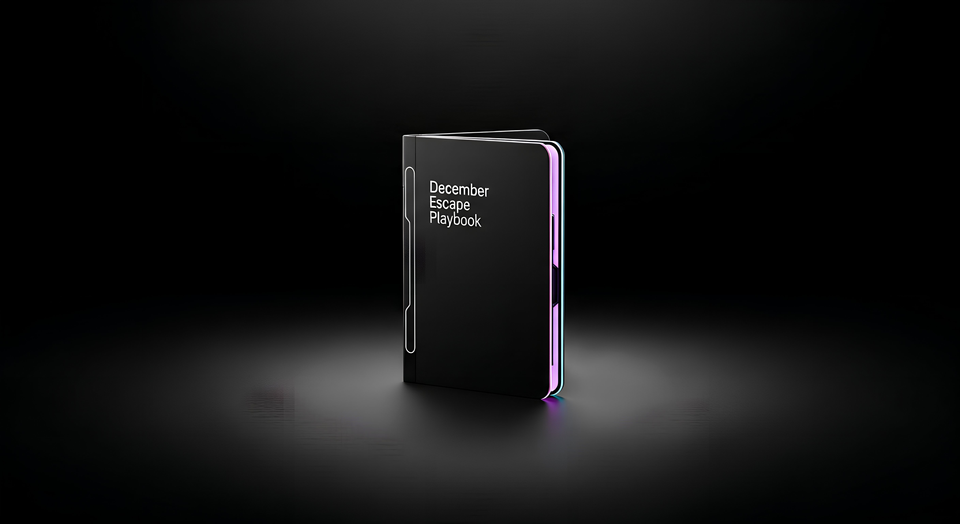Redemption Architecture: How to Lock in Maximum Cents-Per-Point Value
Most SMBs treat points like loose change: spend them fast, take the 1¢, move on. That’s the rookie play. The real game is Redemption Architecture: engineering every burn to hit 3¢–10¢ per point so your “rewards” become a six-figure travel asset, not a line item buried in your budget.


If You Only Had 60 Seconds to Read This Article (Click Here)
Most SMBs take the default one cent per point cash-out, which is the lowest possible return. With the same spend, a disciplined redemption architecture can unlock three to ten cents per point. That turns a million dollars in spend into $30,000 to $100,000 in real market value instead of $10,000 in statement credits.
Redemption architecture is the deliberate plan for deploying points where they produce maximum value. It starts with setting an aspirational benchmark, your personal floor for redemption value. If your realistic peak is six cents per point, a three-cent benchmark forces you to skip low-value redemptions and wait for the right opportunities.
The highest value redemptions consistently appear in luxury international airfare, high-end hotels during peak seasons, and certain partner program awards. The weakest value comes from gift cards, statement credits, and low-cost economy tickets. Tracking target awards, monitoring their cash prices, and keeping points in flexible currencies gives you the leverage to act quickly when value spikes.
Treating points as a managed asset transforms them into a strategic profit lever. Over five years, the difference between redeeming at one cent and four cents can exceed six figures for a high-spend SMB. Without redemption architecture, that upside is lost and the bank captures the value you earned.
Everything else you need to know is just below 👇🏻
🎞️: Powered by NotebookLM @ UpNonStop
The Opening Shock
A professional services firm spends $1.2M annually on corporate cards. They cash out points at one cent each as statement credits. Over the last five years, they’ve “earned” $60,000 in value.
Their peer in the same industry and same city, with identical spend patterns, runs a disciplined redemption strategy. They average 4.8¢ CPM by booking partner business-class flights and luxury hotels at peak season rates. Over the same five years, they’ve extracted $288,000 in real market value from the exact same spend.
That is a $228,000 swing - enough to fund an annual client retreat in Bora Bora, pay for top-tier recruitment perks, or offset a full-time hire.
This is the power of redemption architecture.
What Redemption Architecture Actually Means
Most SMB owners obsess over the earn side of the game - which cards, which categories, which signup bonuses. But that is just ammo acquisition.
Redemption architecture is the battle plan. It is the blueprint for deploying your points where they generate maximum financial impact, not just “free travel.”
Analogy:
- Earn side = building the war chest.
- Redemption architecture = picking the right battles so you don’t waste ammunition.
The baseline reality:
- Bank floor = 1¢ CPM.
- Market ceiling = 10¢ CPM (and sometimes higher in rare cases).
Your job is to move every redemption up the ladder toward the ceiling - not settle for the floor because it is “easy.”
The Math That Changes the Game
Let’s put hard numbers to it.
| Annual Spend | Avg Earn Rate | Points per Year | 1¢ CPM Value | 4¢ CPM Value | Value Delta |
|---|---|---|---|---|---|
| $250,000 | 5% | 150,000 | $1,500 | $6,000 | $4,500 |
| $500,000 | 5% | 300,000 | $3,000 | $12,000 | $9,000 |
| $1,000,000 | 5% | 600,000 | $6,000 | $24,000 | $18,000 |
| $2,000,000 | 5% | 1,200,000 | $12,000 | $48,000 | $36,000 |
Now scale that over a five-year window:
- $500K annual spend: $45,000 difference.
- $2M annual spend: $180,000 difference.
This is hidden margin you can redirect into operations, perks, or owner withdrawals.
The Spread Most SMBs Are Leaving Behind
The danger isn’t that most SMBs earn fewer points - it is that they spend them poorly.
- Default portal bookings at 1¢ to 1.25¢ CPM.
- Statement credits at a flat 1¢.
- Gift cards at 0.85¢ to 1¢.
Every time you redeem below your achievable CPM, you shrink your return on spend. You’d never accept a 1% yield on a 4% bond - yet that is what most SMBs do with points.
The Concept of the Aspirational Benchmark
What It Is
Your aspirational benchmark is the self-imposed floor for redemptions. If the CPM is below this floor, you do not book - period.
This is the first line of defense against low-value burnouts.
Example: A 2.8¢ benchmark means you will never “waste” points on a redemption worth 1.5¢ or less, even if it feels convenient.
How to Set It
- Identify your realistic peak CPM.
- Luxury airfare on certain partners: 5¢–8¢.
- High-season luxury hotels: 3¢–6¢.
- Set your benchmark at 40–50% of peak.
- Peak 6¢ → Benchmark 3¢.
- Peak 5¢ → Benchmark 2.5¢.
This gives you room to score big wins while maintaining flexibility for solid mid-range redemptions.
Where the Multipliers Live
1. Luxury Airfare (International)
- Business class to Europe on ANA, Lufthansa, or Virgin Atlantic often hits 4¢–8¢ CPM.
- First class on Emirates or Singapore Suites can break 10¢ in rare cases.
- Even “sale” award seats in premium cabins can yield 3x–5x the value of economy CPM.
Mini-Case:
$7,200 business-class fare JFK–FRA booked for 110,000 miles + $150 fees = 6.4¢ CPM.
2. High-End Hotels
- Hyatt Category 7 in Paris at peak cash rates of $1,200/night can run 5–6¢ CPM.
- Marriott and Hilton sweet spots exist during high season in Asia or Europe.
Mini-Case:
$950/night property for 30,000 points = 3.16¢ CPM.
3. Specialty Transfers and Partner Awards
- ANA Round-the-World ticket: 22,000+ miles of travel for 125,000–145,000 miles in business class = 8–10¢ CPMvalue.
- Virgin Atlantic Upper Class to Tokyo for 95,000 points + $300 fees = 6¢ CPM.
Where Value Dies
- Bank travel portals without promos or bonuses rarely exceed 1.25¢ CPM.
- Statement credits and gift cards are value flatlines at 1¢ or less.
- Cheap economy tickets have low cash prices, collapsing CPM.
Building the Redemption Map
Your map is your playbook of ready-to-execute awards.
- Keep a target list of 3-5 aspirational redemptions.
- For each, track:
- Average cash price
- Award cost in points/miles
- Resulting CPM at different seasonal prices
- Run dummy searches monthly.
- Log availability patterns - when awards are most often open.
Example Map Entry:
| Target Redemption | Avg Cash Price | Avg Award Cost | Peak CPM | Typical Availability |
|---|---|---|---|---|
| ANA Biz RTW | $24,000 | 145,000 miles | 10¢ | Book 9–11 months out |
| Hyatt Park Hyatt Tokyo | $900/night | 30,000 points | 3¢ | 6–8 months out |
| Virgin ATL–NRT Biz | $5,700 | 95,000 points | 5.6¢ | 10–11 months out |
The SMB Advantage
SMB spend is consistent and recurring. You are not a leisure traveler waiting two years to build a balance - you are earning every month.
This gives you the flexibility to:
- Sit on points until high CPM opportunities appear.
- Book in multiple ecosystems at once.
- Layer partner redemptions for different business needs (client travel, owner perks, incentives).
Case Study:
Consulting firm, $1M annual spend, 5% earn rate = 600,000 points/year.
- Uses 450,000 points for three partner business-class trips at 6¢ CPM = $27,000 value.
- Uses 150,000 points for high-season Hyatt stays at 4¢ CPM = $6,000 value.
Total annual value: $33,000 - vs. $6,000 if cashed at 1¢.
Operational Discipline
The rules that keep your architecture intact:
- No Burn Under X¢ Rule: Company policy forbids redemptions under benchmark CPM.
- Keep points flexible: Hold in transferable currencies until booking.
- Never transfer speculatively: Confirm availability first.
- Monthly availability sweeps: Run dummy bookings for your target list.
- Award cost monitoring: Watch for chart changes and adjust benchmarks if programs devalue.
Avoiding Redemption Panic
Two traps force low CPM redemptions:
- Expiry Pressure - Points are at risk of expiring.
- Keep at least one no-fee card per ecosystem active.
- Make small purchases quarterly to refresh expiration dates.
- No Pipeline - No ready-to-book awards when you want to redeem.
- Maintain at least two “hot standby” redemptions at all times.
Strategic Leverage
Points are an alternate P&L line when managed well.
5-Year Impact Table at $1M Annual Spend (5% Earn):
| CPM | Annual Value | 5-Year Total |
|---|---|---|
| 1¢ | $6,000 | $30,000 |
| 2¢ | $12,000 | $60,000 |
| 4¢ | $24,000 | $120,000 |
| 6¢ | $36,000 | $180,000 |
The difference between 1¢ and 4¢ over five years is $90,000 - pure, untaxed value if redeemed for legitimate business travel.
Pro Plays for Consistently Beating 4¢ CPM
- Partner Sweet Spots: ANA RTW, Virgin Atlantic to Asia, Hyatt Cat 7 in Europe.
- Transfer Bonuses: 20–40% promos from Amex, Chase, Citi to partners.
- Timing Windows: 9–11 months out for premium cabins, 1–7 days out for high-end hotels.
- Strategic Burns: Do not hoard - point inflation hits just like cash inflation.
- Seasonal Awareness: Know when your target routes and properties drop award space.
Final Thoughts
Earning points is easy. Redeeming them for maximum impact is an operational discipline.
Redemption architecture forces you to treat your points portfolio like a managed asset - with benchmarks, tracking, and execution rules.
If you are not consistently hitting your benchmark CPM, you are subsidizing your bank’s profit margins and letting them take luxury travel away from you.
The SMBs who master this do not just travel better - they make their spend perform like a second profit center.




